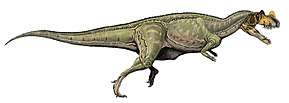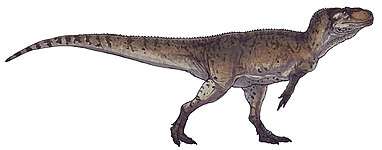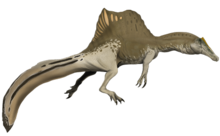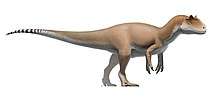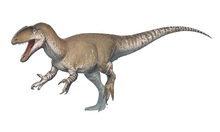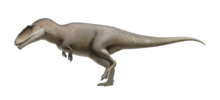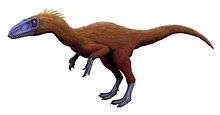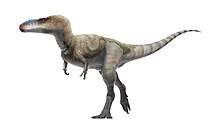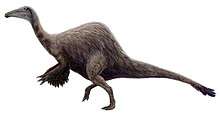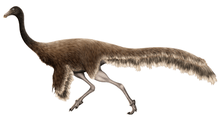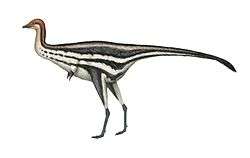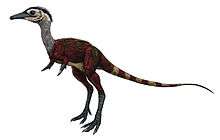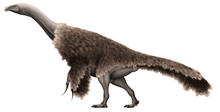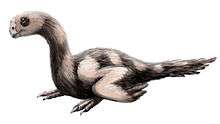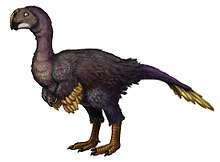Coelophysidae
Coelophysidae is a family of primitive carnivorous theropod dinosaurs. Most species were relatively small in size. The family flourished in the Late Triassic and Early Jurassic periods, and has been found on numerous continents. Many members of Coelophysidae are characterized by long, slender skulls and light skeletons built for speed.[2] One member, Coelophysis, displays the earliest known furcula in a dinosaur.[3]
| Coelophysids | |
|---|---|
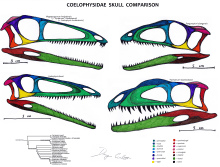 | |
| Skull comparison of Coelophysidae (Coelophysis rhodesiensis at the top left, Panguraptor lufengensis at the top right, Coelophysis bauri at the bottom left, Coelophysis kayentakatae at the bottom right) | |
| Scientific classification | |
| Kingdom: | Animalia |
| Phylum: | Chordata |
| Clade: | Dinosauria |
| Clade: | Saurischia |
| Clade: | Theropoda |
| Superfamily: | †Coelophysoidea |
| Family: | †Coelophysidae Nopcsa, 1923 |
| Type species | |
| †Coelurus bauri Cope, 1887 | |
| Genera | |
| Synonyms | |
| |
Under cladistic analysis, Coelophysidae was first defined by Paul Sereno in 1998 as the most recent common ancestor of Coelophysis bauri and Procompsognathus triassicus, and all of that common ancestor's descendants.[2] However, Tykoski (2005) has advocated for the definition to change to include the additional taxa of "Syntarsus" kayentakatae and Segisaurus halli.[4] Coelophysidae is part of the superfamily Coelophysoidea, which in turn is a subset of the larger Neotheropoda clade.[2] As part of Coelophysoidea, Coelophysidae is often placed as sister to the Dilophosauridae family, however, the monophyly of this clade has often been disputed.[2] The older term "Podokesauridae", named 14 years prior to Coelophysidae (which would normally grant it priority), is now usually ignored, since its type specimen was destroyed in a fire and can no longer be compared to new finds.[5]
Classification
Characteristics
Coelophysids are characterized by slender, skinny builds and long, narrow skulls with large fenestrae to allow for a lighter skull.[6] They are fairly primitive theropods, and so have fairly basal characteristics, such as hollow air sacs in the cervical vertebrae and obligate bipedalism.[6] Their slender builds allowed them to be fast and agile runners. All known members of Coelophysidae are carnivores. One species, Coelophysis bauri has the oldest known furcula (wishbone) of any dinosaur.[3]
It has also been speculated that some species within Coelophysidae, namely Coelophysis bauri, displayed cannibalism, although the fossil evidence behind these claims has been heavily debated (Rinehart et al., 2009; Gay, 2002; Gay, 2010).[7][8][9]
Phylogenetics
Coelophysidae is part of the larger superfamily of Coelophysoidea, which contains Dilophosauridae, Liliensternus, and Zupaysaurus in addition to Coelophysidae.[2][10][11] Coelophysoidea, in turn, is part of the larger clade of Neotheropoda.[2] Of the two major families within Coelophysoidea, Dilophosauridae and Coelophysidae, Coelophysidae is considered to be more basal.[2]
The cladogram below was recovered in a study by Matthew T. Carrano, John R. Hutchinson and Scott D. Sampson, 2005.[12]
| ||||||||||||||||||||||
The cladogram below follows the topology from a 2011 analysis by paleontologists Martin D. Ezcurra and Stephen L. Brusatte, modified with additional data by You Hai-Lu and colleagues in 2014.[1][13]
| |||||||||||||||||||||||||
Biogeography
Fossils of members of Coelophysidae have been found across many continents, including North America, South America, Europe, Asia, and Africa. Powellvenator podocitus was discovered in Northwestern Argentina.[14] Procompsognathus triassicus was discovered in Germany, and Camposaurus arizonensis is from Arizona in North America.[15][13] No coelophysid fossils were known from Asia until the discovery of Panguraptor lufengensis in 2014 in the Yunnan Province of China.[1] The genus Coelophysis has been found in North America, South Africa, and Zimbabwe.[16]
See also
- Timeline of coelophysoid research
- Coelophysoidea
- Coelophysis bauri
References
- Hai-Lu You; Yoichi Azuma; Tao Wang; Ya-Ming Wang; Zhi-Ming Dong (2014). "The first well-preserved coelophysoid theropod dinosaur from Asia". Zootaxa. 3873 (3): 233–249. doi:10.11646/zootaxa.3873.3.3. PMID 25544219.
- Hendrickx, C.; Hartman, S.A.; Mateus, O. (2015). "An overview of non-avian theropod discoveries and classification". PalArch's Journal of Vertebrate Paleontology. 12 (1): 1–73. ISSN 1567-2158.
- Rinehart, L.F.; Lucas, S.G.; Hunt, A.P. (2007). "Furculae in the Late Triassic theropod dinosaur Coelophysis bauri". Paläontolgische Zeitschrift. 81 (2): 174–180. doi:10.1007/BF02988391.
- Tykoski, Ronald S. (2005). Anatomy, Ontogeny, and Phylogeny of Coelophysoid Theropods (PhD). University of Texas at Austin.
- Sereno, P. (1999). "Taxon Search: Coelophysidae Archived 2007-10-07 at the Wayback Machine". Accessed 2009-09-02.
- Nesbitt, Sterling J.; Smith, Nathan D.; Irmis, Randall B.; Turner, Alan H.; Downs, Alex; Norell, Mark A. (2009). "A Complete Skeleton of a Late Triassic Saurischian and the Early Evolution of Dinosaurs". Science. 326 (5959): 1530–1533. Bibcode:2009Sci...326.1530N. doi:10.1126/science.1180350. ISSN 0036-8075. PMID 20007898.
- Rinehart, L.F.; Lucas, S.G.; Heckert, A.B.; Spielmann, J.A.; Celesky, M.D. (2009). "The paleobiology of Coelophysis bauri (Cope) from the Upper Triassic (Apachean) Whitaker quarry, New Mexico, with detailed analysis of a single quarry block". New Mexico Museum of Natural History & Science, a division of the Department of Cultural Affairs Bulletin. 45: 260.
- Gay, R.J. (2002). "The myth of cannibalism in Coelophysis bauri". Journal of Vertebrate Paleontology. 22 (3): 57A.
- Gay, R.J. (2010). Notes on Early Mesozoic Theropods (First ed.). Lulu press. pp. 9-24. ISBN 978-0-557-46616-0
- Ezcurra, M.D.; Novas, F.E. (2007). "Phylogenetic relationships of the Triassic theropod Zupaysaurus rougieri from NW Argentina". Historical Biology. 19 (1): 35–72. doi:10.1080/08912960600845791.
- Nesbitt, S.J.; Ezcurra, M.D. (2015). "The early fossil record of dinosaurs in North America: A new neotheropod from the base of the Upper Triassic Dockum Group of Texas". Acta Palaeontologica Polonica. 60. doi:10.4202/app.00143.2014. ISSN 0567-7920.
- Carrano, M.T; Hutchinson, J.R; Sampson, S.D. (2005). "New information on Segisaurus halli, a small theropod dinosaur from the Early Jurassic of Arizona". Journal of Vertebrate Paleontology. 25 (4): 835–849. doi:10.1671/0272-4634(2005)025[0835:niosha]2.0.co;2.
- Ezcurra, M.D.; Brusatte, S.L. (2011). "Taxonomic and phylogenetic reassessment of the early neotheropod dinosaur Camposaurus arizonensis from the Late Triassic of North America". Palaeontology. 54 (4): 763–772. doi:10.1111/j.1475-4983.2011.01069.x.
- Ezcurra, Martín D. (2017). "A New Early Coelophysoid Neotheropod from the Late Triassic of Northwestern Argentina". Ameghiniana. 54 (5): 506–538. doi:10.5710/amgh.04.08.2017.3100. ISSN 0002-7014.
- Knoll, Fabien (2008). "On the Procompsognathus postcranium (Late Triassic, Germany)". Geobios. 41 (6): 779–786. doi:10.1016/j.geobios.2008.02.002. ISSN 0016-6995.
- Bristowe, A.; Raath, M.A. (2004). "A juvenile coelophysoid skull from the Early Jurassic of Zimbabwe, and the synonymy of Coelophysis and Syntarsus". Palaeontologica Africana. 40: 31–41.
